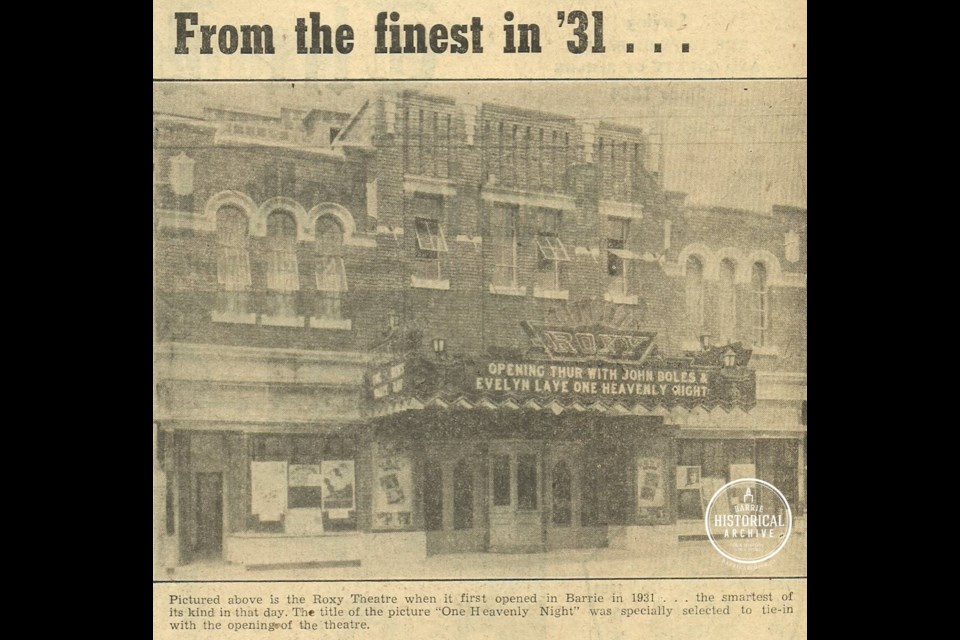If video killed the radio star, then the talkies are responsible for the death of the silent film era.
Semi-rural and conservative Barrie wasn’t known to be on the cutting edge of new innovations in the past. The townsfolk didn’t necessarily embrace things that looked to be frivolous or just passing fads. In fact, they outright balked at such ideas.
An exception was anything theatre related. How Barrie loved its theatre!
Early productions held at the town hall were well attended and the thespian club was a noble group to belong to. In 1891, as the people shouted for an opera house, Nathaniel King opened his music hall at the western edge of present-day Meridian Place.
The music hall sufficed for a short time but an opera house was still sought. In 1896, Sidney Sanford gave the people what they wanted with money from his own apparently deep pockets. Sanford was the county treasurer as well as an amateur actor, and by June of the following year, he had disappeared with rumours of embezzlement following him.
But the people had a Grand Opera House and it was grand in every way. Barrie had landed on the theatre map.
The first moving pictures came to Barrie around 1900. At that time, short films were only a part of what was a live theatrical performance and just a novelty. Also included would be illustrated songs. Music was played and accompanied by a slide show of hand-tinted glass plates depicting the story within the song.
Before the decade was over, travelling picture shows were the norm. By this time, enough of an inventory of actual films had been produced to support film-only shows.
In 1908, it was obvious that moving pictures were here to stay and Barrie’s first dedicated movie theatre opened that year on Dunlop Street West near Maple Avenue. The Dreamland was an instant hit.
In the days before television, this was the place to see sporting spectacles, such as boxing matches, that had been staged in faraway cities and filmed for replay in theatres.
Of course, the big draw then was the same as today – grand dramas with all of the favourite silent movie actors of the day. In the absence of sound, Charlie Chaplin, Lillian Gish, Rudolph Valentino, Mary Pickford and their contemporaries all used over the top facial expressions and body language to get the story across to the audience.
Recorded or live orchestra music accompanied the showing of the film but it wasn’t until the late 1920s that the sound problem was solved and the silent movie era had to give way to the rapid advancement of the talking films, or the ‘talkies’.
This was a wild time to be in the theatre business in Barrie. In 1920, the Dreamland, now billed as the New Dreamland, opened a larger and more state-of-the-art venue just south of Five Points. Three years later, R.F. Garrett opened his Capitol Theatre at 41 Dunlop St. W. His move was loudly protested by both the New Dreamland and the opera house.
The situation reached its craziest point after the building of the Roxy Theatre in 1931. The theatre was large, opulent, and had all the latest technology and it was a definite threat to the pre-existing movie venues of the day.
The Northern Advance of Sept. 7, 1931 reported that two “Barrie theatre owners staged an impromptu matinee performance in police court Saturday morning” when Mrs. Saso of the Roxy and Mr. Garrett of the Capitol appeared after a shouting match and fight over who should be allowed to place an advertising sign on a building on Maple Avenue.
That was just the beginning. In 1932, Eleocadie Beatty, the proprietor of the New Dreamland, took John Saso to court for breech on contract. Mrs. Beatty, claimed that the Saso group, who owned Dreamland but not the building, had agreed to pay her to manage the theatre as a venue for talkies and that she had installed sound equipment without the owner’s permission.
Mrs. Beatty was to show silent films and older talking movies at a discount ticket price while the Sasos presented the latest films in their high-end theatre, the Roxy. In the end, the building owner, who happened to be R.F. Garrett, sued to have the sound equipment removed from his building but the point was moot when a fire all but destroyed the little theatre.
In 1929, the Dreamland Theatre had been the first to show a talking film in Barrie. They were also the last theatre in town to regularly show silent films.
Each week, the Barrie Historical Archive provides BarrieToday readers with a glimpse of the city’s past. This unique column features photos and stories from years gone by and is sure to appeal to the historian in each of us.



